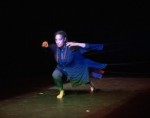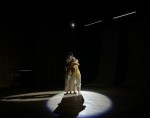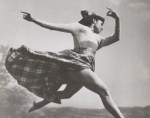
Senga Nengudi Dances with Impermanence
by Jonathan Stein
Senga Nengudi revels in the impermanent. She wrote in 1995 of the "joy of creating impermanent objects most of my life.” Her inventive mix of transient sculptures and ephemeral performance defies categorization and snubs any boundaries that restrict art’s potential. For the past five decades, her singular practice has explored conditions of race, gender, identity, and ultimately art’s role in the world. Senga Nengudi: Topologies is the largest presentation of her extraordinary work, and it should not be missed at the Philadelphia Museum of Art.
Nengudi’s background in dance and movement stands at the core of her work. As a child Nengudi watched the televised performances of Katherine Dunham, the only Black choreographer visible to her, and Fred Astaire, whose tendency to manipulate props in his dancing informed Nengudi’s own practice of using performance to activate objects. She studied a variety of transnational dance styles such as African, Japanese and Mesoamerican, at the Lester Horton company in LA, and as an art instructor she improvised and danced with children at the Pasadena Art Museum. She spent an early, pivotal year in Japan, soaking up Japanese minimalism but also the Gutai experimental and conceptual art movement, which explored relations between materials and the human body and spirit. In raucous, defiant improvisatory actions, performers crashed through paper screens and played with ephemeral, found materials — before there were Happenings by performance artists in the West. Later she would connect with African ritual and dress and currents of African-American improvisation. These influences would fuel her focus on the somatic aspects of sculpture and the activation of them through a performer’s engagement.

Artist Statement, 1996, Photo: Joseph Hu
Portrait Photo: Ron Pollard
The exhibition begins with a reconstruction of one of her earliest major works, Black and Red, a room of hanging black polyethylene forms set against high intensity red-lit walls, creating an environmental experience of contrasts in light and temperature. A small wall note contains the rare museum invitation to touch the hangings, an invitation I accepted to set these black forms in some motion. This seed of the artist’s intent to draw interaction from the viewer was not continued for the rest of the show. Nengudi’s Water Compositions of variously shaped, transparent vinyl pouches containing food-coloring in hues of blue and orange reveal her quirky visions of form and its immateriality (a catalogue essay reports that Nengudi had invited early viewers to feel how they are “undulating to the touch”). Stephanie Weber’s catalogue essay quotes Nengudi’s fellow artist and friend David Hammons’ description of these as so “outrageously abstract” that other artists of the Black Arts Movement would not talk to her as she was not making overtly political and representational work.
During her three years in New York’s East Harlem—a deliberate move away from the largely white downtown abstractionists of the early 70’s avant-garde—she cut flag fabrics to make two-dimensional silhouettes of larger-than-life people, which she called “souls” and “spirits,” tied them to fire escapes, and installed them in alleyways and abandoned lots to be moved by the wind. Down (Purple), a nodding ghostly cut-out, was derived from seeing neighborhood drug addicts, swaying, but never falling completely. “It was such a dance. This movement, unfortunately it was what it was, but it was graceful,” she said.
After a return to LA and the birth of her child, Nengudi initiated her decades long and iconic R.S.V.P., a series of sculptures made out of thrift shop-sourced nylon hose with which she invited performers to “activate,” in her words. Using a found, tactile material, shaped for the body, that is both gendered and used by Black people of all genders to care for their hair, she stretches the nylons into abstract shapes, hanging or pinning them to the walls, floor or ceiling, twisting and tying them into knots, and weighing them down with sand into pendulous forms. These works create a multiplicity of strange, intriguing forms and somatic associations; they are, in her words, “abstracted reflections of used bodies.” In the spirit of the titles of this series, “répondez s’il vous plaît,” Nengudi intends the viewer to interact and have a dialogue with these creations.

Inside/Outside
In one of the many somatic-based variants in the R.S.V.P series, for Inside/Outside she hangs multi-colored, stretched nylon appendages from a hemispheric rubber tube. Variously tied and weighted with sand, the piece suggests internal reproductive organs by its title and shape. In a transformative performance, she uses the entire piece as a headdress or crown that becomes continuous with her body, an extension of her body and hair--a mysterious transformation through adornment. (The performance, like almost all in the exhibit, is documented in archival photographs.)
In another performative activation of an R.S.V.P., titled Performance Piece, Maren Hassinger, Nengudi’s longtime dance-trained collaborator from her days at the Lester Horton studio, is shown in three photographs by Harmon Outlaw where stretched nylon forms are simultaneously attached to a wall and to Hassinger’s body (image at top). The elasticity and tension of the nylon fabric join with Hassinger’s floor movement, and both jointly explore the pathways of restraint and release, tension and stasis, and the nature of animate and inanimate forms and energies. Especially when performer-activated, this work is rich with associations, my own including a perceived transformation into a spider, with the maternal connotations of the spider sculptures of Louise Bourgeois.

Video performance, 2014, White Cube Bermondsey, London, Photo: Joseph Hu
In the only large-screen video of a R.S.V.P.-engaged performance, an eight-minute recording from 2014 filmed at a London art gallery, Hassinger, costumed in the same brown shade as the nylon, creates a duet with the abstracted, linear forms of nylon stretched to the walls and floor. She expands upon these with shapes from her torso and extended limbs as she folds under and around the nylon, releasing a nylon segment to heighten her own body’s extension, and at one point disappears under a brown cloak, forming one object or being.
The PMA exhibition would benefit from accompanying live performance from local movement artists to fulfill the aesthetic spirit of Nengudi’s work and as a fitting institutional or curatorial “réponse.” The pandemic has made presenting live performance challenging, but its absence here might nevertheless reflect a museum hesitant to fully integrate dance and movement into their visual arts exhibitions, something that Nengudi has shown for many decades now to be quite possible and often critical to the realization of her exhibited work.*
Nengudi’s involvement with the LA-based collective of Black artists Studio Z, who organized in the face of exclusion and segregation from the white art world, expands our view of her work. In this artist collective she created communal rituals with Hassinger and Hammons, which were influenced by Yoruba mythology and diasporic ritual. Photographs show Studio Z’s celebratory Ceremony for Freeway Frets, performed with jazz musicians under a LA freeway overpass, and, separately, Nengudi covering her body with masked tape and moving in ghostly transformations, an exploration of her heritage through African mask making.
The show’s last two works of very recent years demonstrate links to her past through radical invention. Her SandminingB from 2020 is a sand painting that covers the entire floor of a large room, a cosmological landscape with small sand mountains topped by colorful pigments of blue and red. A tripartite altar stands watch, centered by twisted nylons wrapping a vertical automobile pipe segment, and it is accompanied by two water constructions with purple and blue dyes. Its transcultural associations with Diné (Navajo) and Indigenous Australian sand paintings, among other cultures, creates a spirit realm for ritual.

“Warp Trance”, 2007, installation photo: Timothy Tibout
Warp Trance, the final tour de force installation that radiates the dynamism of machines in motion, is a hypnotic video (Nengudi’s first), coming out of a 2007 artist’s residency at Philadelphia’s Fabric Workshop and Museum. Researching local textile mill machine weaving processes, and repurposing the Jacquard punch card panels that, pre-computer, programmed the weaving and patterns of the manufactured textiles, Nengudi projects video of the weaving processes onto three large screens of hundreds of these perforated punch cards. The waves, flutters and jiggles of machines and threads in motion create rhythmic dances of colored light and activated machinery, and also project a layer of inscrutable hieroglyphics from the punched cards. The results are captivating and meditative.
Nengudi rejects the presumption that all artists must strive to create enduring objects that will last beyond their lifetimes, stating simply, “This has never been a priority for me. My purpose is to create an experience that will vibrate with the connecting thread.” In Topologies, audiences can feel the delightful hum of that vibration as they move through the exhibit and connect with this extraordinary artist.
*The PMA did commission the Nichole Canuso Dance Company to create a version of The Garden: Invisible Branches, her inter-active dance for the concurrent New Grit show of contemporary, Philadelphia-connected artists. Canuso was the only movement artist of 25 artists presented. tD’s review is here.
Senga Nengudi: Topologies, Philadelphia Museum of Art, May 2-July 25 (admission is free Friday evenings and first Sunday of the month). The PMA is presenting “In Conversation: Senga Nengudi & Linda Goode Bryant,” Thursday, July 1, 5:00–6:00 p.m. There will also be a reading of works inspired by the poetry and art of Nengudi, Thursday, July 22, 6:00-7:00 pm.
By Jonathan Stein
June 16, 2021








